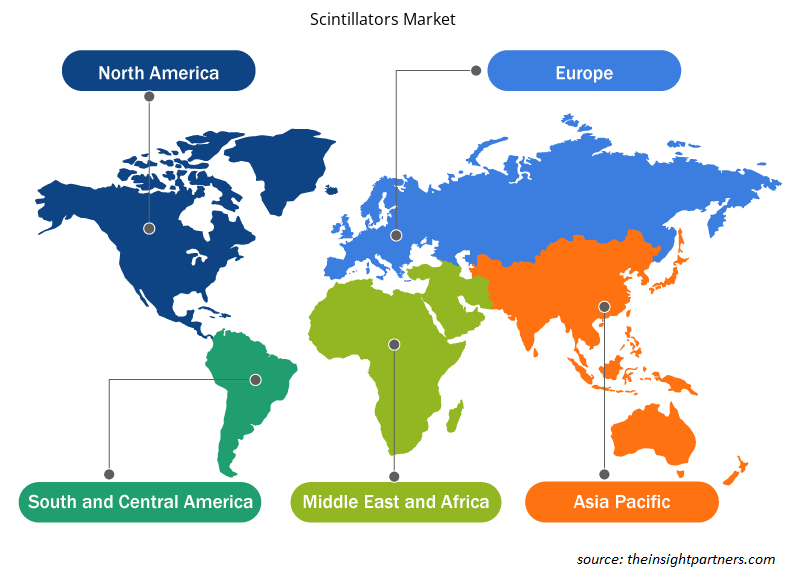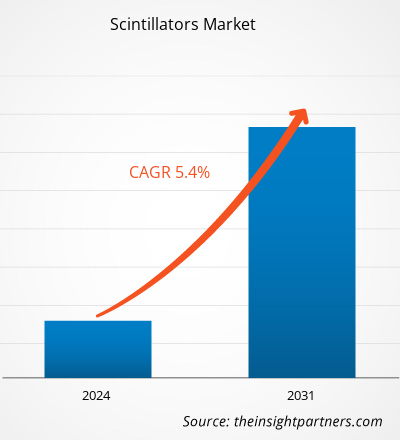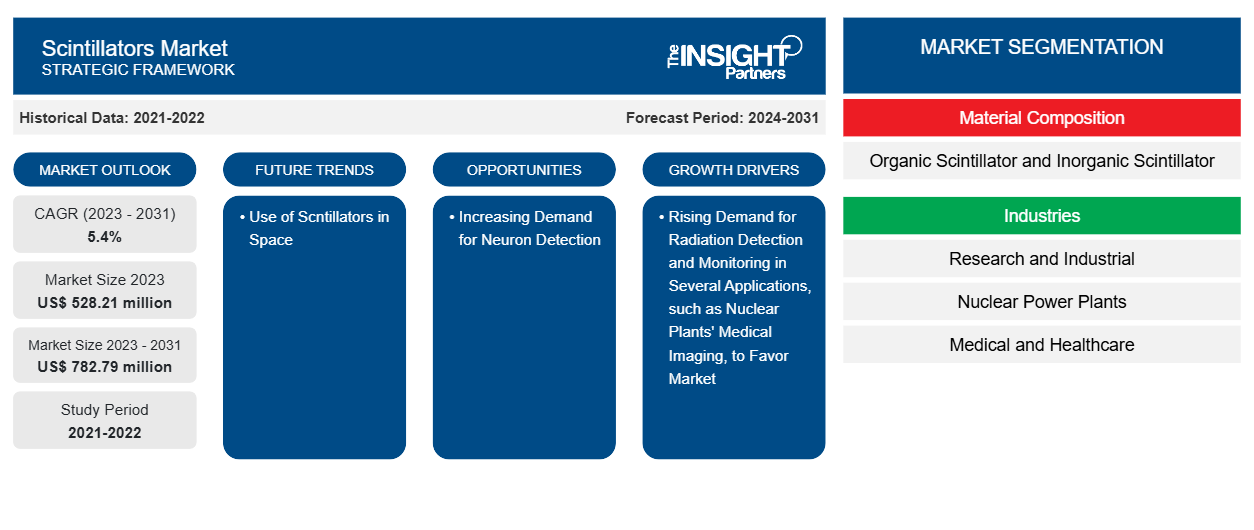Der Markt für Szintillatoren soll von 528,21 Millionen US-Dollar im Jahr 2023 auf 782,79 Millionen US-Dollar im Jahr 2031 anwachsen. Der Markt soll zwischen 2023 und 2031 eine durchschnittliche jährliche Wachstumsrate (CAGR) von 5,04 % verzeichnen. Die steigende Nachfrage nach Strahlungserkennung und -überwachung in verschiedenen Anwendungen, wie z. B. in der medizinischen Bildgebung von Kernkraftwerken, dürfte weiterhin ein wichtiger Trend auf dem Markt für Szintillatoren bleiben.
Szintillator-Marktanalyse
Der Szintillatormarkt erlebt einen großen Wandel aufgrund der sich verändernden Dynamik in den Bereichen Fertigung, Kernkraftwerke, Gesundheitswesen sowie Heimatschutz und Verteidigung. Die Dynamik dieser Branchen hat einen enormen Einfluss auf das Wachstum dieses Marktes. Erhebliche F&E-Ausgaben und staatliche Unterstützung für neuartige Szintillator-Entdeckungen treiben die Expansion des globalen Marktes voran. Zunehmende Investitionen in die Strahlungsüberwachung für den Heimatschutz und der wachsende Bedarf an neuartigen radiologischen Anwendungen sind einige der Faktoren, die den Szintillatormarkt antreiben.
Marktübersicht für Szintillatoren
Szintillator ist ein allgemeiner Begriff für Substanzen, die bei Einwirkung von Strahlung, wie Röntgen- und γ-Strahlen, Fluoreszenz abgeben. Es handelt sich um eine Art Leuchtstoff. Wenn Strahlung auf diese Substanz trifft, absorbiert sie ihre Energie und interne Elektronen bewegen sich vom Grundzustand (stabiler Zustand) in den angeregten Zustand (aufgewühlter Zustand). Wenn dieses Elektron in seinen ursprünglichen stabilen Zustand zurückkehrt, gibt es seine Energie in Form von Lichtemission (sichtbares Licht oder ultraviolettes Licht) frei, und dieses Phänomen wird als Szintillation bezeichnet.
Passen Sie diesen Bericht Ihren Anforderungen an
Sie erhalten kostenlos individuelle Anpassungen an jedem Bericht, einschließlich Teilen dieses Berichts oder einer Analyse auf Länderebene, eines Excel-Datenpakets sowie tolle Angebote und Rabatte für Start-ups und Universitäten.
-
Holen Sie sich die wichtigsten Markttrends aus diesem Bericht.Dieses KOSTENLOSE Beispiel umfasst eine Datenanalyse von Markttrends bis hin zu Schätzungen und Prognosen.
Treiber und Chancen auf dem Szintillatormarkt
Steigende Nachfrage nach Strahlungserkennung und -überwachung in verschiedenen Anwendungen, wie etwa der medizinischen Bildgebung in Kernkraftwerken, begünstigt den Markt
Der Markt für Szintillatoren wird maßgeblich durch den wachsenden Bedarf an Strahlungserkennung und -überwachung in einer Vielzahl von Branchen beeinflusst, darunter Kernkraftwerke und Gesundheitseinrichtungen. Szintillatoren sind aufgrund ihrer präzisen Strahlungserkennungs- und -messfunktionen wesentliche Bestandteile von Strahlungserkennungssystemen, die in diesen Anwendungen eingesetzt werden. Szintillatoren werden in Kernreaktoren zur Strahlungsüberwachung eingesetzt, um die Einhaltung gesetzlicher Vorschriften und die Sicherheit zu gewährleisten. Ebenso sind Szintillatoren unverzichtbar für die Erkennung von Gammastrahlen, die von radioaktiven Tracern in medizinischen Bildgebungsgeräten wie PET-Scannern freigesetzt werden, die bei der Diagnose und Behandlungsplanung helfen. Der zunehmende Fokus auf die innere Sicherheit und die Anforderung der Strahlungserkennung bei Grenzkontrollen und Frachtkontrollen erhöhen den Bedarf an Szintillatoren weiter.scintillators is significantly influenced by the growing need for radiation detection and monitoring across a variety of industries, including Scintillators are essential parts of radiation detection systems utilized in these applications because of their precise radiation detection and measurement capabilities. Scintillators are used in nuclear reactors for radiation monitoring in order to guarantee regulatory compliance and safety. Similar to this, scintillators are essential for detecting gamma rays released by radioactive tracers in medical imaging equipment like PET scanners, which help with diagnosis and treatment planning. The increased focus on homeland security and the requirement for radiation detection in border control and cargo screening further increases the need for scintillators.
Steigende Nachfrage nach Neuronenerkennung
Aufgrund des steigenden Bedarfs an Neutronendetektion dürfte die Marktnachfrage nach Szintillatoren deutlich steigen. Zahlreiche Branchen wie die Kernenergie, die Öl- und Gasförderung sowie die innere Sicherheit sind stark auf Neutronen angewiesen. Neutronen können von Szintillatoren durch Wechselwirkungen nachgewiesen werden, die zu sichtbaren Lichtimpulsen führen. Szintillatorbasierte Detektoren bieten mehrere Vorteile in Anwendungen wie Neutronenradiographie und Neutronenstreuuntersuchungen, darunter hohe Empfindlichkeit, schnelle Reaktionszeiten und die Fähigkeit, zwischen Gamma- und Neutronenstrahlung zu unterscheiden. Darüber hinaus haben die durch Entwicklungen bei Szintillatormaterialien und -technologie erzielten besseren Neutronendetektionsfähigkeiten ihre Attraktivität für eine Vielzahl von Anwendungen erhöht. Der Bedarf an zuverlässigen Neutronendetektionssystemen, die Szintillatoren bieten, dürfte steigen, solange die Industrie weiterhin Effizienz, Sicherheit und Schutz priorisiert. Dies stellt ein erhebliches Potenzial dar.
Segmentierungsanalyse des Szintillator-Marktberichts
Wichtige Segmente, die zur Ableitung der Szintillator-Marktanalyse beigetragen haben, sind Materialzusammensetzung, Branchen und Endprodukte.
Basierend auf der Materialzusammensetzung ist der Szintillatormarkt in organische und anorganische Szintillatoren unterteilt. Das Segment der organischen Szintillatoren dürfte im Prognosezeitraum wachsen.
- Nach Branchen ist der Markt segmentiert in Forschung und Industrie, Kernkraftwerke, Medizin und Gesundheitswesen , Öl und Gas und andere. Das Forschungs- und Industriesegment dürfte im Prognosezeitraum wachsen.
- Basierend auf den Endprodukten wird der Szintillatormarkt in fest installierte und tragbare unterteilt. Das fest installierte Segment dürfte im Prognosezeitraum wachsen.
Marktanteilsanalyse für Szintillatoren nach geografischer Lage
Der geografische Umfang des Szintillatormarktberichts ist hauptsächlich in fünf Regionen unterteilt: Nordamerika, Asien-Pazifik, Europa, Naher Osten und Afrika sowie Südamerika/Süd- und Mittelamerika. APAC hat den Szintillatormarkt dominiert. Hochtechnologische Trends in verschiedenen Branchen in APAC haben das Wachstum des Szintillatormarktes vorangetrieben. Faktoren wie die zunehmende Einführung digitaler Tools und hohe Technologieausgaben von Regierungsbehörden werden voraussichtlich das Wachstum des APAC-Szintillatormarktes vorantreiben. Darüber hinaus zwingt eine starke Betonung von Forschung und Entwicklung in den entwickelten Volkswirtschaften Chinas und Japans die APAC-Akteure dazu, technologisch fortschrittliche Lösungen auf den Markt zu bringen. All diese Faktoren tragen zum Wachstum des Szintillatormarktes in der Region bei.
Regionale Einblicke in den Markt für Szintillatoren
Die regionalen Trends und Faktoren, die den Szintillatormarkt während des Prognosezeitraums beeinflussen, wurden von den Analysten von Insight Partners ausführlich erläutert. In diesem Abschnitt werden auch die Marktsegmente und die Geografie von Szintillatormarkt in Nordamerika, Europa, im asiatisch-pazifischen Raum, im Nahen Osten und Afrika sowie in Süd- und Mittelamerika erörtert.

- Holen Sie sich die regionsspezifischen Daten zum Szintillatormarkt
Umfang des Marktberichts zu Szintillatoren
| Berichtsattribut | Details |
|---|---|
| Marktgröße im Jahr 2023 | 528,21 Millionen US-Dollar |
| Marktgröße bis 2031 | 782,79 Millionen US-Dollar |
| Globale CAGR (2023 - 2031) | 5,4 % |
| Historische Daten | 2021-2022 |
| Prognosezeitraum | 2024–2031 |
| Abgedeckte Segmente |
Nach Materialzusammensetzung
|
| Abgedeckte Regionen und Länder |
Nordamerika
|
| Marktführer und wichtige Unternehmensprofile |
|
Marktteilnehmerdichte: Der Einfluss auf die Geschäftsdynamik
Der Markt für Szintillatoren wächst rasant, angetrieben durch die steigende Nachfrage der Endnutzer aufgrund von Faktoren wie sich entwickelnden Verbraucherpräferenzen, technologischen Fortschritten und einem größeren Bewusstsein für die Vorteile des Produkts. Mit steigender Nachfrage erweitern Unternehmen ihr Angebot, entwickeln Innovationen, um die Bedürfnisse der Verbraucher zu erfüllen, und nutzen neue Trends, was das Marktwachstum weiter ankurbelt.
Die Marktteilnehmerdichte bezieht sich auf die Verteilung von Firmen oder Unternehmen, die in einem bestimmten Markt oder einer bestimmten Branche tätig sind. Sie gibt an, wie viele Wettbewerber (Marktteilnehmer) in einem bestimmten Marktraum im Verhältnis zu seiner Größe oder seinem gesamten Marktwert präsent sind.
Die wichtigsten auf dem Szintillatormarkt tätigen Unternehmen sind:
- Strahlungsüberwachungsgeräte.
- Hamamatsu Photonics KK
- Hitachi, Ltd
- Ludlum Measurements, Inc.
- Rexon Components, Inc.
- Szintacor
Haftungsausschluss : Die oben aufgeführten Unternehmen sind nicht in einer bestimmten Reihenfolge aufgeführt.

- Überblick über die wichtigsten Akteure auf dem Szintillationsmarkt
Neuigkeiten und aktuelle Entwicklungen zum Szintillatormarkt
Der Szintillatormarkt wird durch die Erhebung qualitativer und quantitativer Daten nach Primär- und Sekundärforschung bewertet, die wichtige Unternehmensveröffentlichungen, Verbandsdaten und Datenbanken umfasst. Im Folgenden finden Sie eine Liste der Entwicklungen auf dem Markt:
- Im Juni 2021 gab Saint-Gobain die Preisverleihung für die 16. Ausgabe seines internationalen Studentenwettbewerbs „Multi-Comfort“ bekannt. In diesem Jahr bestand die Herausforderung darin, das postindustrielle Gebiet des Unternehmens Coignet in Saint-Denis (Frankreich) in ein Wohn-, Lern- und Freizeitgebiet im Herzen einer großen Grünfläche umzuwandeln und dabei sowohl das historische Erbe als auch die Anforderungen an eine nachhaltige Entwicklung moderner Viertel zu respektieren, und zwar in Zusammenarbeit mit der Stadt Saint-Denis.
(Quelle: Saint-Gobain, Pressemitteilung, 2023)
Marktbericht zu Szintillatoren – Umfang und Ergebnisse
Der Bericht „Marktgröße und Prognose für Szintillatoren (2021–2031)“ bietet eine detaillierte Analyse des Marktes, die die folgenden Bereiche abdeckt:
- Marktgröße und Prognose auf globaler, regionaler und Länderebene für alle wichtigen Marktsegmente, die im Rahmen des Projekts abgedeckt sind
- Marktdynamik wie Treiber, Beschränkungen und wichtige Chancen
- Wichtige Zukunftstrends
- Detaillierte PEST/Porters Five Forces- und SWOT-Analyse
- Globale und regionale Marktanalyse mit wichtigen Markttrends, wichtigen Akteuren, Vorschriften und aktuellen Marktentwicklungen
- Branchenlandschaft und Wettbewerbsanalyse, einschließlich Marktkonzentration, Heatmap-Analyse, prominenten Akteuren und aktuellen Entwicklungen
- Detaillierte Firmenprofile
- Historische Analyse (2 Jahre), Basisjahr, Prognose (7 Jahre) mit CAGR
- PEST- und SWOT-Analyse
- Marktgröße Wert/Volumen – Global, Regional, Land
- Branchen- und Wettbewerbslandschaft
- Excel-Datensatz
Aktuelle Berichte
Erfahrungsberichte
Grund zum Kauf
- Fundierte Entscheidungsfindung
- Marktdynamik verstehen
- Wettbewerbsanalyse
- Kundeneinblicke
- Marktprognosen
- Risikominimierung
- Strategische Planung
- Investitionsbegründung
- Identifizierung neuer Märkte
- Verbesserung von Marketingstrategien
- Steigerung der Betriebseffizienz
- Anpassung an regulatorische Trends























 Kostenlose Probe anfordern für - Markt für Szintillatoren
Kostenlose Probe anfordern für - Markt für Szintillatoren